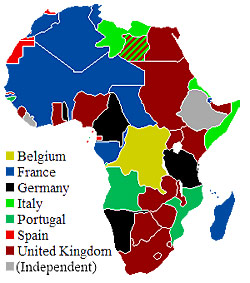
Unit 4: Nationalism, Industrialism, and Imperialism
Lesson C: European Division of the African Continent
Lesson Overview
Africa is a continent with many natural resources. Historically, Europeans traded with Africans to secure the resources that they desired. Europeans set up trading posts along the coasts. These trading posts also served as resupply stations for European ships. Beginning in the mid 19th century, European countries' desire to colonize Africa increased. During the 19th century, Europeans developed medicines and other advances that led to their ability to overpower the Africans. European countries often came into conflict with one another over the desire to claim more land. This potential conflict led to a treaty that set rules for colonizing Africa. This colonization led to conflict with natives as well as changes in native Africans way of life.

European Control of Africa, 1914 [1]
Key Questions
- How and why did Europeans become involved in Africa?
- How did Europeans treat the native African populations?
- How did European imperialism lead to conflict in Africa?
- How did the geo-political aspects of Africa change as a result of imperialism?
- How and why did imperialism transform political, economic, and social systems?
Student Outcomes
- Analyze the reasons for European imperialism throughout Africa, including the Berlin Conference and internal cultural, social, and political conflict.
- Explain the major changes in the political geography of northern and Sub-Saharan Africa between 1880 and 1914.
- Analyze how the abolition of the Atlantic slave trade and increased output of European manufactured goods affected economies of West and Central Africa.
- Describe the rise of the Zulu Empire and analyze its effects on African societies and European colonial settlements.
- Compare the sources and effectiveness of military, political, and religious resistance movements in Ethiopia and in regions such as Algeria, Morocco, West Africa, Sudan, and South Africa.
- Evaluate multiple perspectives of various peoples in the past by demonstrating their differing motives and beliefs. (Historical Thinking Skill)
Key Terms
- balance of power
- depose
- ethnic groups
- geo-political
- manufactured goods
- missionary
- mother country
- nationalism
- raw materials
- scientific racism
- treaty
Student Resources
- Africa Organization Chart Pre-Imperialism (doc)
- Regions of Africa Jigsaw Factsheets (pdf)
- Regions of Africa Jigsaw Graphic Organizer (doc)
- Scramble for Africa (doc)
- Historical Investigation — Labor in Africa (doc)
- Africa Organization Chart during Imperialism (doc)
- Imperialism in Africa Brief Constructed Response (BCR) (doc)
Chart of Activities
| Activities to Complete | Estimated Time |
|---|---|
| Pre-Assessment | 5 minutes |
| Key Terms | 5 minutes |
| Activator: 19th Century Imperialism | 5 minutes |
| Opening: Africa Prior to European Imperialism | 20 minutes |
| Activity 1: Early Interactions between Europe and Africa | 15 minutes |
| Activity 2: Review - Europe Claims Africa | 15 minutes |
| Activity 3: Interactions with Africa | 15 minutes |
| Activity 4: Scramble for Africa | 10 minutes |
| Activity 5: European Treatment of African Labor | 20 minutes |
| Activity 6: Conflict and Resistance in Africa - South Africa | 10 minutes |
| Activity 7: Conflict and Resistance in Africa - Algeria | 10 minutes |
| Activity 8: Conflict and Resistance in Africa - Asante | 10 minutes |
| Activity 9: Conflict and Resistance in Africa - Ethiopia | 10 minutes |
| Activity 10: The Zulus | 10 minutes |
| Activity 11: Africa during Imperialism | 20 minutes |
| Review and Assessment | 15 minutes |
| Lesson Summary | 5 minutes |
Lesson Completion Time
The total estimated time to complete this lesson is 200 minutes.
Page Notes:
[1] Source: This image from http://commons.wikimedia.org/wiki/File:Colonial_Africa_1914_map.png is licensed under the terms of the GNU License Agreement.

